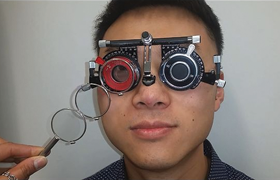Purpose: We usually use objective and subjective methods for examination of the eye astigmatism in optometry, respectively ophthalmology. Objective methods enable to measure sphere-cylindrical refraction of the eye. If we want to prescribe new glasses or contact lenses we usually use subjective methods. The aim of this study was to measure sensitivity and specificity of some subjective and objective methods for examination of the eye astigmatism. We supposed that automatic objective refraction will be the most exact method so we choose this method as the reference method. For comparison we chose subjective methods Jackson crossed cylinders (JCC), fogging method (FM) and objective method Spot Vision Screener (SVS, Welch Allyn).
Materials and methods: We had in total 30 subjects with average age 23 years (SD 1 year) in our study. We made each measurement per eye separately and it was independent measurement so we could use measurement from each eye (n = 60). Each eye was firstly measured by subjective method FM, followed by JCC method and finally was use objective method Spot Vision Screener (SVS, Welch Allyn). Measurement with objective instrument TRK-1P (TOPCON) was use as reference measurement. The significance level was set at p = 0.05.
Results: In variable FM we measured sensitivity 76.2 % and specificity 66.7 %. Criterion for positive finding was -0.25 D. Result was statistically significant on level p < 0.001. In variable JCC we measured sensitivity 95.2 % and specificity 66.7 %. Criterion for positive finding was -0.25 D. Result was statistically significant on level p < 0.001. In variable SVS we measured sensitivity 47.6 % and specificity 94.4 %. Criterion for positive finding was -0.75 D. Result was statistically significant on level p < 0.001. Direct comparison of all methods showed statistically important difference between techniques JCC and FM
(p = 0.0095). In other method we did not find statistically important difference (FM vs. SVS, p = 0.526 and JCC vs. SVS, p = 0.105).
Conclusion: All subjective and objective techniques were statistically significant in detection of eye astigmatism. Comparison of ROC curves showed statistically significant difference between FM and JCC technique. The JCC method showed the highest sensitivity, whereas SVS highest specificity.

